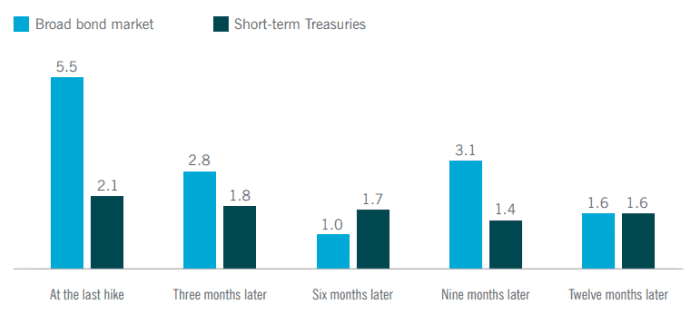This post was originally published on this site
Investors sitting on the sidelines in cash and in money-market funds might consider moving into longer-dated bonds sooner rather than later, according to Saira Malik, chief investment officer at Nuveen.
As look at historical returns shows the broader $55 trillion U.S. bond market typically outperforms short-term Treasurys at the end of past Federal Reserve rate hiking cycles since the 1990s.
The bond market produced an average 5.5% three-month rolling return following the last rate hike (see chart) in the past four Fed hiking cycles, while short-term Treasurys returned 2.1%.

This data includes the three-month rolling average performance of bonds in all Federal Reserve rate-hiking cycles since 1990 (1995, 2000, 2006 and 2018) based on the Bloomberg U.S. Aggregate Bond Index and the Bloomberg U.S. Treasury 1-3 Year Index
Bloomberg, Nuveen
Of note, the magnitude of the bond market’s outperformance faded by 12 months versus short-term positions, when looking at the Bloomberg U.S. Aggregate Bond Index’s performance relative to the Bloomberg U.S. Treasury 1-3 Year Index.
“The broad market typically experienced a strong relief rally immediately after the Fed pause and mostly outperformed the following year,” Malik said, in a Monday client note. “This lends further credence to our view that overallocating to cash or short-term government debt could be a mistake — and that investors may want to start closing their duration underweights.”
Related: Investors skeptical about a ‘soft landing’ are more bullish on longer-dated bonds
Individuals can gain exposure to Wall Street bond indexes through related exchange-traded funds, including the iShares Core U.S. Aggregate Bond ETF
AGG
and the SPDR Bloomberg 1-3 Year U.S. Treasury Bond UCITS ETF
UK:TSY3
for short-term Treasury exposure.
Fed Chairman Jerome Powell signaled on Friday that additional rate hikes might be needed to keep the U.S. cost of living in retreat, even though rates already sit at a 22-year high and inflation has fallen sharply in the past year, while speaking at the annual Jackson Hole gathering in Wyoming. He also reiterated a vow to keep rates at a restrictive level for a while to keep inflation in check.
Malik pointed to cooling housing inflation as a positive sign on the inflation front. Home buyers have pulling back as the benchmark 30-year mortgage rate hit an average of 7.31%, the highest levels since 2000.
She also expects U.S. economic growth to slow and a “partial retracing” of the 10-year Treasury yield
BX:TMUBMUSD10Y,
following its surge in recent weeks.
“Historically, the 10-year yield has peaked within the last few months of the final rate hike in a tightening cycle. We expect this hike will occur at either the September or November Fed meeting, and that the 10-year yield will decline through year-end.” Yields and debt prices move opposite each other.
Related: Pimco emerges as a buyer in Treasury market selloff, says Bond Vigilante theme ‘a bit extreme’
Stocks were higher Tuesday, with the Dow Jones Industrial Average
DJIA
up 0.3%, the S&P 500 index
SPX
0.9% higher and the Nasdaq Composite Index
COMP
up 1.4%, according to FactSet.



